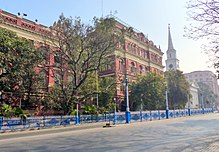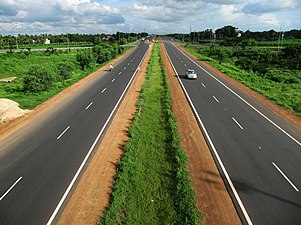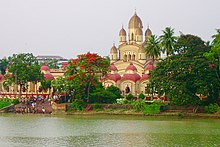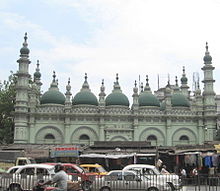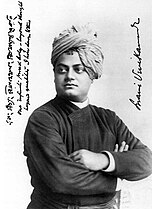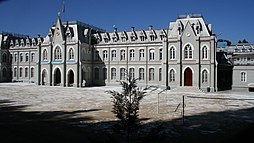West Bengal
West Bengal | ||
|---|---|---|
|
Clockwise from top: Howrah Bridge; Chhau dance in Purulia; Durga Puja; Bengal tiger in Sundarbans National Park; Darjeeling from Happy Valley Tea Estate; Digha beach; Hazarduari Palace; Dakshineswar Kali Temple | ||
|
by bifurcation )15 August 1947 | | |
State Legislature | Unicameral | |
| • Assembly | West Bengal Legislative Assembly (294 seats) | |
| National Parliament | Parliament of India | |
| • Rajya Sabha | 16 seats | |
| • Lok Sabha | 42 seats | |
| High Court | Calcutta High Court | |
| Area | ||
| • Total | 88,752 km2 (34,267 sq mi) | |
| • Rank | Song Banglar Mati Banglar Jol | (The Soil of Bengal, The Water of Bengal)[1] |
| Bird | White-throated kingfisher | |
| Fish | Ilish | |
| Flower | Night-flowering jasmine | |
| Fruit | Mango | |
| Mammal | Fishing cat | |
| Tree | Chhaatim tree | |
| State highway mark | ||
 | ||
| State highway of West Bengal WB SH1 - WB SH15 | ||
| List of Indian state symbols | ||
| ^The Province of Bengal was split into two states i.e. West Bengal and East Bengal (present-day Bangladesh) by the Indian Independence Act 1947[11] †† Partition of Bengal (1947) | ||
West Bengal (
The area's early history featured a succession of
The region was a hotbed of the
Post-Indian independence, as a
Etymology
The origin of the name Bengal (Bangla and Bongo in Bengali) is unknown. One theory suggests the word derives from "Bang", the name of a Dravidian tribe that settled the region around 1000 BCE.[30] The Bengali word Bongo might have been derived from the ancient kingdom of Vanga (or Banga). Although some early Sanskrit literature mentions the name Vanga, the region's early history is obscure.[31]
In 1947, at the end of British rule over the Indian subcontinent the Bengal Legislative Council and the Bengal Legislative Assembly voted on the Partition of Bengal along religious lines into two separate entities: West Bengal, which continued as an Indian state and East Bengal, a province of Pakistan, which came to be known be as East Pakistan and later became the independent Bangladesh.[11][32]
In 2011 the Government of West Bengal proposed a change in the official name of the state to Paschim Banga (Bengali: পশ্চিমবঙ্গ Pôshchimbônggô).[33] This is the native name of the state, literally meaning "western Bengal" in the native Bengali language. In August 2016 the West Bengal Legislative Assembly passed another resolution to change the name of West Bengal to "Bengal" in English and "Bangla" in Bengali. Despite the Trinamool Congress government's efforts to forge a consensus on the name change resolution, the Indian National Congress, the Left Front and the Bharatiya Janata Party opposed the resolution.[34] However, the central government has turned down the proposal maintaining the state should have one single name for all languages instead of three and it should not be the same as that of any other territory (pointing out that the name 'Bangla' may create confusion with neighbouring Bangladesh).[34][35][36]
History
Ancient and classical period

The kingdom of
Two kingdoms—Vanga or Samatata, and Gauda—are said in some texts to have appeared after the end of the Gupta Empire although details of their ascendancy are uncertain.
Medieval and early modern periods

Subsequent Muslim conquests helped spread Islam throughout the region.
Colonial period

Several European traders reached this area in the late 15th century. The

The Bengal Renaissance and the Brahmo Samaj socio-cultural reform movements significantly influenced the cultural and economic life of Bengal.[61] Between 1905 and 1911 an abortive attempt was made to divide the province of Bengal into two zones.[62] Bengal suffered from the Great Bengal famine in 1943, which claimed three million lives during World War II.[63] Bengalis played a major role in the Indian independence movement, in which revolutionary groups such as Anushilan Samiti and Jugantar were dominant.[19] Armed attempts against the British Raj from Bengal reached a climax when news of Subhas Chandra Bose leading the Indian National Army against the British reached Bengal. The Indian National Army was subsequently routed by the British.[64]
Indian independence and afterwards
When India
During the 1970s and 1980s, severe power shortages, strikes and a violent
The state's economic recovery gathered momentum after the central government introduced economic liberalisations in the mid-1990s. This was aided by the advent of information technology and IT-enabled services. Beginning in the mid-2000s, armed activists conducted minor terrorist attacks in some parts of the state.[69][70] Clashes with the administration took place at several controversial locations over the issue of industrial land acquisition.[71][72] This became a decisive reason behind the defeat of the ruling Left Front government in the 2011 assembly election.[73] Although the economy was severely damaged during the unrest in the 1970s, the state has managed to revive its economy steadily throughout the years.[74][75][76] The state has shown improvement regarding bandhs (strikes)[77][78][79] and educational infrastructure.[80] Significant strides have been made in reducing unemployment,[81] though the state suffers from substandard healthcare services,[82][83] a lack of socio-economic development,[84] poor infrastructure,[85] unemployment and civil violence.[86][87] In 2006 the state's healthcare system was severely criticised in the aftermath of the West Bengal blood test kit scam.[88][89]
Geography
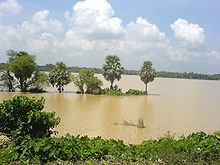
West Bengal is on the
The main river in West Bengal is the
West Bengal's climate varies from
Flora and fauna
The "India State of Forest Report 2017", recorded forest area in the state is 16,847 km2 (6,505 sq mi),
From a
The distribution of vegetation in northern West Bengal is dictated by elevation and
3.26% of the geographical area of West Bengal is protected land, comprising fifteen wildlife sanctuaries and five national parks—
Government and politics
West Bengal is governed through a
Prior to this, West Bengal was ruled by the Left Front for 34 years (1977–2011), making it the world's longest-running democratically elected
Districts and cities
Districts


As of 1 November 2023,[update] West Bengal is divided into 23 districts.[114]
| District | Population | Growth rate | Sex ratio | Literacy | Density per square Kilometer |
|---|---|---|---|---|---|
| North 24 Parganas | 10,009,781 | 12.04 | 955 | 84.06 | 2445 |
South 24 Parganas |
8,161,961 | 18.17 | 956 | 77.51 | 819 |
| Purba Bardhaman | 4,835,432 | – | 945 | 74.73 | 890 |
| Paschim Bardhaman | 2,882,031 | – | 922 | 78.75 | 1800 |
| Murshidabad | 7,103,807 | 21.09 | 958 | 66.59 | 1334 |
| West Midnapore | 5,913,457 | 13.86 | 966 | 78.00 | 631 |
| Hooghly | 5,519,145 | 9.46 | 961 | 81.80 | 1753 |
| Nadia | 5,167,600 | 12.22 | 947 | 74.97 | 1316 |
| East Midnapore | 5,095,875 | 15.36 | 938 | 87.02 | 1081 |
| Howrah | 4,850,029 | 13.50 | 939 | 83.31 | 3306 |
| Kolkata | 4,496,694 | −1.67 | 908 | 86.31 | 24306 |
Maldah |
3,988,845 | 21.22 | 944 | 61.73 | 1069 |
| Jalpaiguri | 3,872,846 | 13.87 | 953 | 73.25 | 622 |
| Alipurduar[a] | 1,700,000 | – | – | – | 400 |
| Bankura | 3,596,292 | 12.64 | 954 | 70.95 | 523 |
| Birbhum | 3,502,404 | 16.15 | 956 | 70.68 | 771 |
| North Dinajpur | 3,007,134 | 23.15 | 939 | 59.07 | 958 |
| Purulia | 2,930,115 | 15.52 | 957 | 64.48 | 468 |
| Cooch Behar | 2,819,086 | 13.71 | 942 | 74.78 | 832 |
| Darjeeling | 1,846,823 | 14.77 | 970 | 79.56 | 586 |
| Dakshin Dinajpur | 1,676,276 | 11.52 | 956 | 72.82 | 755 |
| Kalimpong[a] | 202,239 | – | – | – | 270 |
| Jhargram[a] | 1,136,548 | – | – | – | 374 |
Each district is governed by a
Cities
The capital and largest city of the state is
Major
Economy
| Net State Domestic Product at Factor Cost at Current Prices (2004–05 Base)[121] (figures in crores of Indian rupees) | |
| Year | Net State Domestic Product |
|---|---|
| 2004–2005 | 190,073 |
| 2005–2006 | 209,642 |
| 2006–2007 | 238,625 |
| 2007–2008 | 272,166 |
| 2008–2009 | 309,799 |
| 2009–2010 | 366,318 |
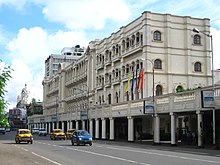
As of 2015[update], West Bengal has the sixth-highest
In 2015–2016, the percentage share of Gross Value Added (GVA) at factor cost by economic activity at the constant price (the base year 2011–2012) was Agriculture-Forestry and Fishery—4.84%, Industry 18.51% and Services 66.65%. It has been observed that there has been a slow but steady decline in the percentage share of industry and agriculture over the years.
Years after independence, West Bengal is dependent on the central government for help in meeting its demands for food; food production remained stagnant, and the

In the period 2004–2010, the average gross state domestic product (GSDP) growth rate was 13.9% (calculated in Indian rupee terms) lower than 15.5%, the average for all states of the country.[127]: 4
The economy of West Bengal has witnessed many surprising changes in direction. The agricultural sector in particular rose to 8.33% in 2010–11 before tumbling to −4.01% in 2012–13.
However, over the years due to effective changes in the stance towards industrialisation, ease of doing business has improved in West Bengal.[135][136][137] Steps are being taken to remedy this situation by promoting West Bengal as an investment destination. A leather complex has been built in Kolkata. Smart cities are being planned close to Kolkata, and major roadway projects are in the offing to revive the economy.[138] West Bengal has been able to attract 2% of the foreign direct investment in the last decade.[139]
Transport
-
Netaji Subhash Chandra Bose International Airportis a hub for flights to and from Bangladesh, East Asia, Nepal, Bhutan and north-east India.
-
Durgapur Expressway
-
An SBSTC bus in Karunamoyee
-
Kolkata Metro, India's first metro rail system
As of 2011, the total length of surface roads in West Bengal was over 92,023 kilometres (57,180 miles);[127]: 18 national highways comprise 2,578 km (1,602 mi)[140] and state highways 2,393 km (1,487 mi).[127]: 18 As of 2006, the road density of the state was 103.69 kilometres per square kilometre (166.87 miles per square mile), higher than the national average of 74.7 km/km2 (120.2 mi/sq mi).[141]
As of 2011, the total railway route length was around 4,481 km (2,784 mi).
Kolkata is a major river port in eastern India. The
Several government-owned organisations operate bus services in the state, including: the
Demographics
| Year | Pop. | ±% |
|---|---|---|
| 1901 | 16,940,088 | — |
| 1911 | 17,998,769 | +6.2% |
| 1921 | 17,474,348 | −2.9% |
| 1931 | 18,897,036 | +8.1% |
| 1941 | 23,229,552 | +22.9% |
| 1951 | 26,300,000 | +13.2% |
| 1961 | 34,926,000 | +32.8% |
| 1971 | 44,312,000 | +26.9% |
| 1981 | 54,581,000 | +23.2% |
| 1991 | 68,078,000 | +24.7% |
| 2001 | 80,176,000 | +17.8% |
| 2011 | 91,276,115 | +13.8% |
| 2022 | 98,604,000 | +8.0% |
| Source: Census of India[153] | ||
According to the provisional results of the 2011 national census, West Bengal is the fourth-most-populous state in India with a population of 91,347,736 (7.55% of India's population).[3] The state's 2001–2011 decennial population growth rate was 13.93%,[3] lower than the 1991–2001 growth rate of 17.8%[3] and lower than the national rate of 17.64%.[154] The gender ratio is 947 females per 1,000 males.[154] As of 2011, West Bengal had a population density of 1,029 inhabitants per square kilometre (2,670/sq mi) making it the second-most densely populated state in India, after Bihar.[154]
The literacy rate is 77.08%, higher than the national rate of 74.04%.
In September 2017, West Bengal achieved 100% electrification, after some remote villages in the Sunderbans became the last to be electrified.[159]
As of September 2017, of 125 towns and cities in Bengal, 76 have achieved
A study conducted in three districts of West Bengal found that accessing private health services to treat illness had a catastrophic impact on households. This indicates the importance of the public provision of health services to mitigate poverty and the impact of illness on poor households.[162]
The latest Sample Registration System (SRS) statistical report shows that West Bengal has the lowest
There are a small number of
Languages
The state's official languages are Bengali and English;
Religion
Religion in West Bengal (2011)[170]
West Bengal is religiously diverse, with regional cultural and religious specificities. Although
The Hindu population of West Bengal is 64,385,546 while the Muslim population is 24,654,825, according to the 2011 census.[175]
Culture
Literature
The Bengali language boasts a rich literary heritage it shares with neighbouring Bangladesh. West Bengal has a long tradition of folk literature, evidenced by the
Music and dance

A notable music tradition is the Baul music, practised by the
Films
Fine arts
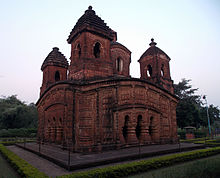
There are significant examples of fine arts in Bengal from earlier times, including the terracotta art of Hindu temples and the Kalighat paintings. Bengal has been in the vanguard of modernism in fine arts. Abanindranath Tagore, called the father of modern Indian art, started the Bengal School of Art, one of whose goals was to promote the development of styles of art outside the European realist tradition that had been taught in art colleges under the British colonial administration. The movement had many adherents, including: Gaganendranath Tagore, Ramkinkar Baij, Jamini Roy and Rabindranath Tagore. After Indian Independence, important groups such as the Calcutta Group and the Society of Contemporary Artists were formed in Bengal and came to dominate the art scene in India.[199][200]
Reformist heritage
The capital, Kolkata, was the workplace of several social reformers, including
Cuisine
Rice and fish are traditional favourite foods, leading to a saying in Bengali, "machhe bhate bangali", that translates as "fish and rice make a Bengali".
Clothing

Bengali women commonly wear the
West Bengal produces several varieties of cotton and silk saris in the country. Handlooms are a popular way for the state's rural population to earn a living through weaving. Every district has weaving clusters, which are home to artisan communities, each specialising in specific varieties of handloom weaving. Notable handloom saris include tant, jamdani, garad, korial, baluchari, tussar and muslin.[210]
Festivals
Durga Puja is the biggest, most popular and widely celebrated festival in West Bengal.[211] The five-day-long colourful Hindu festival includes intense celebration across the state. Pandals are erected in various cities, towns, and villages throughout West Bengal. The city of Kolkata transforms Durga Puja. It is decked up in lighting decorations and thousands of colourful pandals are set up where effigies of the goddess Durga and her four children are displayed and worshipped. The idols of the goddess are brought in from Kumortuli, where idol-makers work throughout the year fashioning clay models of the goddess. Since independence in 1947, Durga Puja has slowly changed into more of a glamorous carnival than a religious festival. Today people of diverse religious and ethnic backgrounds partake in the festivities.[212] On Vijayadashami, the last day of the festival, the effigies are paraded through the streets with riotous pageantry before being immersed into the rivers.[213]
Other major festivals of West Bengal include:
Eid al-Fitr is the most important Muslim festival in West Bengal. They celebrate the end of Ramadan with prayers, alms-giving, shopping, gift-giving, and feasting.[215]
Christmas, called Bôŗodin (Great day) is perhaps the next major festival celebrated in Kolkata, after Durga Puja. Although Hinduism is the major religion in the state, people show significant passion to the festival. Just like Durga Puja, Christmas in Kolkata is an occasion when all communities and people of every religion take part. Large masses of people go to parks, gardens, museums, parties, fairs, churches and other places to celebrate the day. A lot of Hindus go to Hindu-temples and the festival is celebrated there too with Hindu rituals.
Each year between July and August (on the eve of the month of Shravan) in Tarakeswar Yatra held, nearly 10 million devotees come from various part of India bringing holy water of Ganga from Nimai Tirtha Ghat of Baidyabati, which is almost 39 km (24 mi) from Tarakeswar, in order to offer it to Lord Shiva. During that month, a line of people in saffron-dyed clothes stretches over the full 39 km (24 mi). It is the longest and largest Mela of West Bengal.
Poush Mela is a popular winter festival of Shantiniketan, with performances of folk music, Baul songs, dance, and theatre taking place throughout the town.[215]
Ganga Sagar Mela coincides with the Makar Sankranti, and hundreds of thousands of Hindu pilgrims converge where the river Ganges meets the sea to bathe en masse during this fervent festival.[214]
Education
-
University of Calcutta, the oldest public university of India.
-
The front entrance to the academic block of NUJS, Kolkata.
-
Prajna Bhavan, housing the School of Mathematical Sciences and School of RKMVU.
West Bengal schools are run by the state government or private organisations, including religious institutions. Instruction is mainly in English or Bengali, though Urdu is also used, especially in Central Kolkata. Secondary schools are affiliated with the Council for the Indian School Certificate Examinations (CISCE), the Central Board for Secondary Education (CBSE), the National Institute of Open School (NIOS), West Bengal Board of Secondary Education, or the West Bengal Board of Madrasah Education.[220]
As of 2016 85% of children within the 6 to 17-year age group attend school (86% do so in urban areas and 84% in rural areas). School attendance is almost universal among the 6 to 14-year age group then drops to 70% with the 15 to 17-year age group. There is a gender disparity in school attendance in the 6 to 14-year age group, more girls than boys are attending school. In Bengal, 71% of women aged 15–49 years and 81% of men aged 15–49 years are literate. Only 14% of women aged 15–49 years in West Bengal have completed 12 or more years of schooling, compared with 22% of men. 22% of women and 14% of men aged 15–49 years have never attended school.[221]
Some of the notable schools in the city are:
West Bengal has eighteen universities.
The
Other higher education institutes of importance in West Bengal include:
Jadavpur University (Focus area—Mobile Computing and Communication and Nano-science), and the University of Calcutta (Modern Biology) are among two of the fifteen universities selected under the "University with Potential for Excellence" scheme. University of Calcutta (Focus Area—Electro-Physiological and Neuro-imaging studies including mathematical modelling) has also been selected under the "Centre with Potential for Excellence in a Particular Area" scheme.[232]
In addition, the state is home to
There are several research institutes in Kolkata. The
Notable scholars who were born, worked, or studied in the geographic area of the state include physicists:
Media
In 2005 West Bengal had 505 published newspapers,
Sports


West Bengal has several large stadiums. Eden Gardens was one of only two 100,000-seat cricket stadiums in the world;[250] renovations before the 2011 Cricket World Cup reduced the capacity to 66,000.[251] The stadium is the home to various cricket teams such as the Kolkata Knight Riders, the Bengal cricket team and the East Zone. The 1987 Cricket World Cup final was hosted in Eden Gardens. The Calcutta Cricket and Football Club is the second-oldest cricket club in the world.[252]
Notable sports persons from West Bengal include former
See also
- Bangal
- Bengali Language Movement
- Ghoti people
- List of people from West Bengal
- List of tourist attractions in West Bengal
- Outline of West Bengal
References
- ^ "West Bengal Assembly passes resolution declaring Rabindranath Tagore composition as state anthem". Scroll.in. 7 September 2023. Retrieved 8 September 2023.
- ^ "Sandakphu". 25 December 2008. Archived from the original on 25 December 2008. Retrieved 24 March 2023.
- ^ a b c d e "Area, population, decennial growth rate and density for 2001 and 2011 at a glance for West Bengal and the districts: provisional population totals paper 1 of 2011: West Bengal". Registrar General & Census Commissioner, India. Archived from the original on 7 January 2012. Retrieved 26 January 2012.
- ^ The Telegraph. 11 December 2012. Archived from the original on 25 March 2018. Retrieved 25 March 2018.from the original on 23 December 2020. Retrieved 31 December 2020.
—"Kurukh language given official status by Bengal government". Outlook. 21 February 2017. Archived from the original on 22 January 2021. Retrieved 12 October 2020.
—Roy, Anirban (28 February 2018). "Kamtapuri, Rajbanshi make it to list of official languages in". India Today. Archived from the original on 30 March 2018. Retrieved 30 March 2018.
—"West Bengal shows 'Mamata' to Telugus". The Hans India. 24 December 2020. Archived - ^ a b c "Financial Statements 2023-24, Government of West Bengal" (PDF). Government of West Bengal. 1 February 2023. p. 21. Archived (PDF) from the original on 23 February 2023. Retrieved 1 February 2023.
- ^ "Handbook of Statistics of Indian States 2022-23" (PDF). Reserve Bank of India. pp. 11, 33. Retrieved 15 September 2023.
- ^ "STATE-WISE DATA ON PER CAPITA INCOME". Delhi: PIB Delhi. 24 July 2023. Retrieved 12 September 2023.
- ^ a b "Sub-national HDI – Area Database". Global Data Lab. 15 June 2021. Retrieved 7 March 2023.
- ^ NSO (2018). "Sex ratio, 0–6 age population, literates and literacy rate by sex for 2001 and 2011 at a glance for West Bengal and the districts: provisional population totals paper 1 of 2011: West Bengal" (PDF). Government of India:Ministry of Home Affairs. Archived from the original on 7 January 2012.
- ^ "Sex ratio, 0–6 age population, literates and literacy rate by sex for 2001 and 2011 at a glance for West Bengal and the districts: provisional population totals paper 1 of 2011: West Bengal". Government of India:Ministry of Home Affairs. Archived from the original on 7 January 2012. Retrieved 29 January 2012.
- ^ a b Mukherjee 1987, p. 230.
- ^ "West Bengal Population 2023". World Population Review. 13 July 2023. Retrieved 13 July 2023.
- ^ ISBN 978-1-136-82552-1. Archivedfrom the original on 16 January 2023. Retrieved 7 February 2021.
- ^ a b Shombit Sengupta, Bengals plunder gifted the British Industrial Revolution Archived 1 August 2017 at the Wayback Machine, The Financial Express, 8 February 2010
- ^ Chaudhury, Sushil; Mohsin, KM (2012). "Sirajuddaula". In Islam, Sirajul; Jamal, Ahmed A. (eds.). Banglapedia: National Encyclopedia of Bangladesh (Second ed.). Asiatic Society of Bangladesh. Archived from the original on 14 June 2015.
- ^ Campbell & Watts 1760.
- ISBN 978-1-61530-142-3.
- ISBN 978-981-15-3045-6.
- ^ ISBN 9780823931804. Archivedfrom the original on 2 February 2023. Retrieved 12 August 2020.
- ISBN 978-0-521-67256-6
- ISBN 978-0-203-45060-4
- ^ ISBN 81-7955-030-3. Archived from the original(PDF) on 27 May 2006. Retrieved 26 August 2006.
- ^ The Telegraph. Kolkata. Archived from the originalon 18 January 2012. Retrieved 4 March 2012.
- ^ "Handbook of Statistics of Indian States 2021-22" (PDF). Reserve Bank of India. pp. 37–42. Archived (PDF) from the original on 29 January 2022. Retrieved 11 November 2022.
- ^ "Invest in West Bengal - Business Opportunities, Industries, FDI". Archived from the original on 14 November 2022. Retrieved 14 November 2022.
- ^ "FDI in India | FDI Consultant | FDI Companies | FDI Opportunities 2022". Archived from the original on 14 November 2022. Retrieved 14 November 2022.
- ^ "State Finances: A Risk Analysis". Reserve Bank of India. 16 June 2022. Retrieved 16 June 2022.
- ^ UNESCO 2012.
- ^ "India Tourism Statistics at a Glance 2023" (PDF). Government of India: 21. Archived (PDF) from the original on 18 December 2019. Retrieved 27 September 2023.
- ^ "Bangladesh: early history, 1000 B.C.–A.D. 1202". Bangladesh: A country study. Washington, D.C.: Library of Congress. September 1988. Archived from the original on 15 June 2017. Retrieved 2 March 2012.
Historians believe that Bengal, the area comprising present-day Bangladesh and the Indian state of West Bengal, was settled in about 1000 B.C. by Dravidian-speaking peoples who were later known as the Bang. Their homeland bore various titles that reflected earlier tribal names, such as Vanga, Banga, Bangala, Bangal and Bengal.
- ^ Marshman, John Clark (1865). Outline of the History of Bengal. John Clark Marshman. p. 1. Archived from the original on 4 December 2017.
- ^ Chakrabarty 2004, p. 142.
- ^ "West Bengal may be renamed PaschimBanga". The Hindu. Chennai, India. 19 August 2011. Archived from the original on 21 January 2012. Retrieved 7 February 2012.
- ^ from the original on 25 December 2016. Retrieved 4 January 2018.
- ^ "Foreign ministry turns down Mamata Banerjee's 'Bangla' for West Bengal". The New Indian Express. Archived from the original on 22 December 2017. Retrieved 20 December 2017.
- ^ "West Bengal to send another proposal to Centre on changing its name". Hindustan Times. 8 September 2017. Archived from the original on 22 December 2017. Retrieved 20 December 2017.
- The Telegraph. Calcutta, India. Archived from the originalon 12 September 2011. Retrieved 13 September 2010.
Humans walked on Bengal's soil 20,000 years ago, archaeologists have found out, pushing the state's pre-history back by some 8,000 years.
- ISBN 978-81-224-1198-0. Archivedfrom the original on 1 January 2016.
- ISBN 978-81-7824-016-9.
- ISBN 978-81-7017-053-2. Archivedfrom the original on 2 February 2023. Retrieved 21 October 2020.
- ISBN 978-81-206-0218-2. Archivedfrom the original on 2 February 2023. Retrieved 21 October 2020.
- ^ Sultana, Sabiha. "Settlement in Bengal (Early Period)". Banglapedia. Asiatic Society of Bangladesh. Archived from the original on 14 June 2015. Retrieved 12 June 2015.
- ISBN 978-81-208-0440-1.
- ISBN 978-81-224-1198-0. Archivedfrom the original on 31 December 2015.
- ^ "Shashanka". Banglapedia. Asiatic Society of Bangladesh. Archived from the original on 14 June 2015. Retrieved 12 June 2015.
- ^ Joseph, Tony (11 December 2015). "Intolerance debate: How some historical brutalities are more special than others". Scroll.in. Archived from the original on 25 December 2015. Retrieved 25 December 2015.
- ISBN 978-81-7017-301-4. Archivedfrom the original on 23 April 2016.
- ISBN 978-1-84774-062-5. Archivedfrom the original on 26 January 2018.
- ISBN 978-0-14-341678-4. Archivedfrom the original on 1 January 2016.
- ISBN 978-81-7141-682-0.
- ISBN 978-81-8069-149-2.
Bengal [...] was rich in the production and export of grain, salt, fruit, liquors and wines, precious metals and ornaments besides the output of its handlooms in silk and cotton. Europe referred to Bengal as the richest country to trade with.
- ISBN 978-90-04-09497-0. Archivedfrom the original on 1 January 2014.
- ^ "Islam (in Bengal)". Banglapedia. Asiatic Society of Bangladesh. Archived from the original on 23 July 2015. Retrieved 26 October 2006.
- ISBN 978-1-139-50257-3.
- ISBN 9788170173045. Archivedfrom the original on 2 February 2023. Retrieved 12 August 2020.
- ^ Chaudhury, S; Mohsin, KM. "Sirajuddaula". Banglapedia. Asiatic Society of Bangladesh. Archived from the original on 14 June 2015. Retrieved 12 June 2015.
- ^ Fiske, John. "The famine of 1770 in Bengal". The Unseen World, and Other Essays. Adelaide: University of Adelaide Library Electronic Texts Collection. Archived from the original on 5 December 2006. Retrieved 26 October 2006.
- ^ Arnold-Baker 2015, p. 504
- ^ Baxter 1997, p. 32
- ^ Bayly 1987, pp. 194–197
- ^ Sarkar 1990, p. 95
- ^ Baxter 1997, pp. 39–40
- ISBN 978-0-520-22172-7. Archivedfrom the original on 9 May 2013. Retrieved 2 March 2012.
- ^ Chandra 1989, p. 26
- ^ Islam, Sirajul. "Partition of Bengal, 1947". Banglapedia. Asiatic Society of Bangladesh. Archived from the original on 2 July 2015. Retrieved 12 June 2015.
- ^ ISBN 81-86860-23-1
- ^ Hindle 1996, pp. 63–70
- ^ a b Biswas, Soutik (16 April 2006). "Calcutta's colourless campaign". BBC. Archived from the original on 14 February 2012. Retrieved 15 February 2012.
- ^ Ghosh Roy, Paramasish (22 July 2005). "Maoist on rise in West Bengal". VOA Bangla. Voice of America. Archived from the original on 12 December 2007. Retrieved 11 September 2006.
- ^ "Maoist Communist Centre (MCC)". Left-wing extremist group. South Asia Terrorism Portal. Archived from the original on 12 February 2012. Retrieved 11 September 2006.
- ^ "Several hurt in Singur clash". Rediff.com. 28 January 2007. Archived from the original on 11 December 2007. Retrieved 15 March 2007.
- The Telegraph. Calcutta, India. 15 March 2007. Archived from the originalon 17 March 2007. Retrieved 15 March 2007.
- ^ Bhaumik, Subir (13 May 2011). "Defeat rocks India's elected communists". Rediff India Abroad. Archived from the original on 4 April 2014. Retrieved 29 July 2014.
- ^ "Is West Bengal's economy actually reviving under Mamata Banerjee?". scroll.in. Archived from the original on 6 December 2016.
- ^ "West Bengal tax revenue up 19% on greater efficiency". The Indian Express. Archived from the original on 4 September 2017.
- ^ "Revenue collection: Mamata Banerjee's West Bengal beats rest of India in growth". Financial Express. Archived from the original on 4 September 2017.
- ^ "Bharat Bandh gets mixed response from India, West Bengal surprises with business-as-usual attitude". India Today. Archived from the original on 30 November 2016. Retrieved 5 September 2017.
- ^ "No bandh in Bengal tomorrow : Mamata". Business Standard India. Business Standard. Press Trust of India. September 2016. Archived from the original on 4 September 2017.
- India Times. Archivedfrom the original on 10 September 2017.
- ^ "Silent Resurrection~I". The Statesman. 24 August 2017. Archived from the original on 28 August 2017.
- ^ "Report on Fifth Annual Employment-Unemployment Survey (2015–16)" (PDF). Ministry of Labour and Employment. p. 120. Archived (PDF) from the original on 25 November 2016. Retrieved 24 November 2016.
- ^ Shah, Mansi (2007). "Waiting for health care: a survey of a public hospital in Kolkata" (PDF). Centre for Civil Society. Archived from the original (PDF) on 13 August 2011. Retrieved 31 January 2012.
- ^ "West Bengal: health systems development initiative programme memorandum" (PDF). Government of West Bengal. 15 January 2005. Archived (PDF) from the original on 13 March 2012. Retrieved 4 March 2012.
- ^ "Impact of social sector development in West Bengal – Midnapore and Birbhum districts". Planning Commission of India. Archived from the original on 7 March 2012. Retrieved 4 March 2012.
- The Telegraph. Kolkata. 13 June 2010. Archived from the originalon 19 January 2012. Retrieved 4 March 2012.
- ^ Ramesh, Randeep (12 November 2007). "Six killed as farmers and communists clash in West Bengal". The Guardian. London. Archived from the original on 1 September 2013. Retrieved 4 March 2012.
- ^ "West Bengal political violence continues". The Economic Times. New Delhi. 8 August 2009. Archived from the original on 25 July 2018. Retrieved 4 March 2012.
- ^ "Unknown vs The State of West Bengal on 14 November, 2014". indiankanoon.org. Archived from the original on 19 November 2018. Retrieved 19 November 2018.
- ^ "Defective blood-test kits in West Bengal". Archived from the original on 19 November 2018. Retrieved 19 November 2018.
- The Telegraph. Kolkata. Archived from the originalon 31 July 2013. Retrieved 16 February 2012.
- ISBN 9789048135813. Archivedfrom the original on 2 February 2023. Retrieved 13 December 2017.
- ISBN 978-81-7156-898-7.
- The Hindu Business Line. Chennai. 4 August 2006. Archived from the originalon 7 May 2013. Retrieved 4 March 2012.
- from the original on 18 March 2017. Retrieved 26 January 2018.
- ^ a b "Climate". West Bengal: Land. Suni System (P) Ltd. Archived from the original on 23 May 2006. Retrieved 5 September 2006.
- ^ "kal Baisakhi". Glossary of Meteorology. American Meteorological Society. Archived from the original on 30 August 2006. Retrieved 5 September 2006.
- Times of India. 12 March 2017. Archivedfrom the original on 20 August 2017. Retrieved 2 July 2017.
- ^ Mukherjee, Krishnendu (13 February 2018). "Bengal green cover up by just 21 sq km, aided by plantations". The Times of India. Archived from the original on 22 August 2019. Retrieved 7 May 2018.
- ^ "West Bengal" (PDF). fsi.nic.in. Archived (PDF) from the original on 13 July 2019. Retrieved 22 August 2019.
- ^ "Forest cover" (PDF). India state of forest report 2013. Forest Survey of India, Ministry of Environment & Forests, Government of India. p. 17. Archived from the original (PDF) on 14 July 2014. Retrieved 21 July 2014.
- ^ a b c "Forest and tree resources in states and union territories: West Bengal" (PDF). India state of forest report 2009. Forest Survey of India, Ministry of Environment & Forests, Government of India. pp. 163–166. Archived from the original (PDF) on 1 May 2013. Retrieved 4 March 2012.
- ^ Islam, Sadiq (29 June 2001). "World's largest mangrove forest under threat". CNN. Archived from the original on 22 August 2007. Retrieved 31 October 2006.
- ^ a b c Mukherji, S.J. (2000). College Botany Vol. III: (chapter on Phytogeography). Calcutta: New Central Book Agency. pp. 345–365.
- UNESCO World Heritage Centre. Archivedfrom the original on 6 March 2012. Retrieved 4 March 2012.
- ^ a b "Natural vegetation". West Bengal. Suni System (P) Ltd. Archived from the original on 23 May 2006. Retrieved 31 October 2006.
- ^ "West Bengal: General Information". India in Business. Federation of Indian Chambers of Commerce and Industry. Archived from the original on 19 August 2006. Retrieved 25 August 2006.
- ^ a b West Bengal Human Development Report 2004, pp. 200–203, Ch. 10: Problems of Specific Regions
- ^ "West Bengal legislative assembly". Legislative bodies in India. National Informatics Centre, India. Archived from the original on 13 March 2016. Retrieved 28 October 2006.
- ^ Delimitation Commission (15 February 2006). "Notification: order no. 18" (PDF). New Delhi: Election Commission of India. pp. 23–25. Archived from the original (PDF) on 13 August 2011. Retrieved 11 February 2012.
- ^ "Composition of Rajya Sabha" (PDF). Rajya Sabha at work. New Delhi: Rajya Sabha Secretariat. pp. 24–25. Archived from the original (PDF) on 5 March 2016. Retrieved 15 February 2012.
- ^ "Statewise results – West Bengal". Election Commission of India. Archived from the original on 16 May 2011. Retrieved 13 May 2011.
- from the original on 24 November 2016. Retrieved 4 January 2018.
- ^ "Gorkhaland Territorial Administration Agreement signed". Outlook. 18 July 2011. Archived from the original on 3 June 2012. Retrieved 16 March 2012.
- ^ "District Profiles". Archived from the original on 22 April 2017.
- ^ "Section 2 of West Bengal Panchayat Act, 1973 – West Bengal Judicial Academy" (PDF). West Bengal Judicial Academy. Archived (PDF) from the original on 22 December 2016. Retrieved 26 January 2018.
- ^ "Directory of district, sub division, panchayat samiti/ block and gram panchayats in West Bengal, March 2008". West Bengal Electronics Industry Development Corporation Limited, Government of West Bengal. March 2008. p. 1. Archived from the original (DOC) on 7 December 2013. Retrieved 15 February 2012.
- ^ a b "Urban agglomerations/cities having population 1 million and above" (PDF). Provisional population totals, census of India 2011. The Registrar General & Census Commissioner, India. 2011. Archived (PDF) from the original on 15 December 2011. Retrieved 26 January 2012.
- ^ "Cities having population 1 lakh and above, census 2011" (PDF). Provisional population totals, census of India 2011. The Registrar General & Census Commissioner, India. Archived (PDF) from the original on 7 May 2012. Retrieved 18 October 2011.
- ^ Diplomat, Ankit Panda, The. "Geography's Curse: India's Vulnerable 'Chicken's Neck'". The Diplomat. Archived from the original on 21 October 2017. Retrieved 10 December 2017.
{{cite news}}: CS1 maint: multiple names: authors list (link) - ^ "2011 Census of India" (PDF). censusindia.gov.in. Archived (PDF) from the original on 23 July 2013.
- ^ "Net state domestic product at factor cost—state-wise (at current prices)". Handbook of statistics on Indian economy. Reserve Bank of India. 15 September 2011. Archived from the original on 9 March 2012. Retrieved 7 February 2012.
- ^ "GSDP at current prices, 2004–05 series (2004–05 to 2014–15)". Archived from the original on 18 July 2016.
- ^ "Centre accepts Bengal GDP has crossed Rs 10L cr". The Times of India. 3 August 2018. Archived from the original on 6 August 2018. Retrieved 15 October 2018.
- ^ a b "GSDP at current prices, Percent growth (2004–05 to 2014–15)". Archived from the original on 17 July 2016.
- ^ "Per Capita NSDP at current prices, Percent growth (2004–05 to 2014–15) – NITI Aayog". niti.gov.in. Archived from the original on 16 July 2016. Retrieved 25 July 2016.
- ^ "Economic Review 2015–16" (PDF). Archived from the original (PDF) on 15 August 2016.
- ^ a b c d e f "West Bengal" (PDF). India Brand Equity Foundation. November 2011. Archived (PDF) from the original on 17 May 2012. Retrieved 6 February 2012.
- ^ a b "Industrial infrastructure". West Bengal Industrial Development Corporation. Archived from the original on 5 April 2012. Retrieved 5 March 2012.
- ^ "About West Bengal State: Tourism, Industries, Agriculture, Economy & Geography". IBEF. Archived from the original on 9 December 2016. Retrieved 4 January 2018.
- ^ a b c West Bengal Human Development Report 2004, pp. 4–6, Ch. 1: Introduction and Human Development Indices for West Bengal
- ^ "Mamata seeks debt restructuring plan for West Bengal". The Economic Times. New Delhi. 22 October 2011. Retrieved 4 March 2012.[dead link]
- The Telegraph. Archived from the originalon 3 February 2018. Retrieved 3 February 2018.
- from the original on 8 January 2020. Retrieved 3 February 2018.
- ^ Sarkar, Debasis (26 June 2017). "Darjeeling fears continuing Gorkhaland agitation to hurt festive tourism business". The Economic Times. Archived from the original on 3 February 2018. Retrieved 3 February 2018.
- ^ "'Ease of doing business improves in West Bengal". The Hindu. 17 March 2018. Archived from the original on 2 January 2020. Retrieved 18 March 2018.
- Business Standard India. Press Trust of India. 17 March 2018. Archivedfrom the original on 18 March 2018. Retrieved 18 March 2018.
- ^ "West Bengal bags top spot in Ease of Doing Business; Here's the full ranking list". The Financial Express. 17 March 2018. Archived from the original on 18 March 2018. Retrieved 18 March 2018.
- ^ "Industrial Development in West Bengal, GSDP of West Bengal". IBEF. Archived from the original on 1 September 2018. Retrieved 3 February 2018.
- ^ "The city that got left behind". The Economist. 7 January 2012. Archived from the original on 1 February 2018. Retrieved 31 January 2018.
- ^ "Statewise Length of national highways in India". National Highways. Department of Road Transport and Highways; Ministry of Shipping, Road Transport and Highways; Government of India. Archived from the original on 22 October 2012. Retrieved 9 February 2012.
- ^ Chattopadhyay, Suhrid Sankar (January–February 2006). "Remarkable Growth". The Hindu; Frontline. 23 (2). Archived from the original on 19 March 2012. Retrieved 15 October 2013.
- ^ "Kolkata Metro is now the 17th zone of Indian Railways". The Times of India. 29 December 2010. Archived from the original on 2 February 2023. Retrieved 26 January 2018.
- ^ "Geography : Railway Zones". IRFCA.org. Indian Railways Fan Club. Archived from the original on 19 August 2007. Retrieved 31 August 2007.
- ^ "About Kolkata Metro". Kolkata Metro. Archived from the original on 20 August 2007. Retrieved 1 September 2007.
- UNESCO World Heritage Centre. Archivedfrom the original on 3 May 2006. Retrieved 30 April 2006.
- ^ "Profile on Kazi Nazrul Islam International Airport". Centre for Asia Pacific Aviation. Archived from the original on 8 August 2014. Retrieved 5 August 2014.
- ^ Mishra, Mihir (18 May 2015). "Air India operates inaugural flight between Durgapur & Kolkata". The Economic Times. Archived from the original on 2 August 2017. Retrieved 19 May 2015.
- Kolkata Port Trust, India. Archivedfrom the original on 19 January 2012. Retrieved 9 February 2012.
- Times Internet Limited. Archived from the originalon 16 October 2007. Retrieved 31 August 2007.
- The Hindu Business Line. Archivedfrom the original on 26 January 2018. Retrieved 10 December 2017.
- ^ "[IRFCA] Indian Railways FAQ: IR History: Early Days – 1". www.irfca.org. Archived from the original on 7 March 2005.
- ISBN 978-1-4666-4996-5. Archivedfrom the original on 2 February 2023. Retrieved 21 October 2020.
- ^ "Census of India Website : Office of the Registrar General & Census Commissioner, India". www.censusindia.gov.in. Archived from the original on 8 August 2019. Retrieved 8 August 2019.
- ^ a b c "Table 1: Distribution of population, sex ratio, density and decadal growth rate of population: 2011". Provisional population totals paper 1 of 2011 India: series 1. Registrar General & Census Commissioner, India. Archived from the original on 12 February 2012. Retrieved 16 February 2012.
- ^ "Table 2(3): Literates and literacy rates by sex : 2011". Provisional population totals paper 1 of 2011 India: series 1. Registrar General & Census Commissioner, India. Archived from the original on 12 February 2012. Retrieved 16 February 2012.
- ^ "Contents 2010–14" (PDF). Registrar General and Census Commissioner of India. Archived (PDF) from the original on 13 November 2016. Retrieved 12 January 2017.
- ^ "Abridged Life Tables- 2010–14" (PDF). Registrar General and Census Commissioner of India. p. 5. Archived (PDF) from the original on 10 January 2017. Retrieved 12 January 2017.
- ^ "Table 162, Number and Percentage of Population Below Poverty Line". Reserve Bank of India, Government of India. 2013. Archived from the original on 7 April 2014. Retrieved 20 April 2014.
- ^ "Bengal is 100% electrified now". The Times of India, Kolkata. 3 November 2017.
- ^ Chakrabarti, Suman (6 September 2017). "76 Bengal towns free of open defecation". The Times of India.
- ^ Dutta, Saptarshi (7 September 2017). "With 76 Towns And Cities Already Open Defecation Free, West Bengal Aims To Reach The 100% Mark by the End of This Year". NDTV. Archived from the original on 17 October 2018. Retrieved 16 October 2018.
- ^ Kanjilal, Barun; Swadhin Mondal; Moumita Mukherjee; Debjani Barman; Arnab Mondal (October 2008). "Catastrophic Health Care Payment: how much protected are the users of public hospitals?". FHS Research Brief (4). Archived from the original on 9 March 2013.
- ^ "Why West Bengal is like Canada, and Bihar like Swaziland". 25 December 2014. Archived from the original on 24 July 2016.
- ISBN 978-0-7391-1325-7. Archivedfrom the original on 10 May 2013. Retrieved 16 February 2012.
- ISBN 978-0-19-513977-8. Archivedfrom the original on 2 February 2023. Retrieved 21 October 2020 – via Google Books.
- ISBN 978-1-118-25726-5. Archivedfrom the original on 2 February 2023. Retrieved 21 October 2020 – via Google Books.
- ISBN 978-81-905835-5-8. Archivedfrom the original on 9 May 2013. Retrieved 29 January 2012.
- ISBN 978-81-905835-5-8. Archivedfrom the original on 9 May 2013. Retrieved 29 January 2012.
- ^ a b "Table C-16 - Population by Mother Tongue". www.censusindia.gov.in. Office of the Registrar General & Census Commissioner, India. Archived from the original on 15 August 2018. Retrieved 18 September 2021.
- ^ "Population by religion community – 2011". Census of India, 2011. The Registrar General & Census Commissioner, India. Archived from the original on 25 August 2015.
- ^ B.P. Syam Roy (28 September 2015). "Bengal's topsy-turvy population growth". The Statesman. Archived from the original on 10 September 2016.
- ^ Singh, Shiv Sahay (26 February 2016). "Could it take two to tango with Mamata?". The Hindu. Archived from the original on 29 February 2016.
- ^ "Data on Religion". Census of India (2001). Office of the Registrar General & Census Commissioner, India. Archived from the original on 12 August 2007. Retrieved 26 August 2006.
- ISBN 978-1-349-16310-6. Archivedfrom the original on 2 February 2023. Retrieved 21 October 2020.
- ^ Seni, Saibal (26 August 2015). "Bengal beats India in Muslim growth rate". The Times of India. Archived from the original on 21 July 2017.
- ISBN 978-3-935001-06-9.
- ISBN 978-0-7007-1185-7.
- ^ "Bankim Chandra: The First Prominent Bengali Novelist". The Daily Star. 30 June 2011. Archived from the original on 6 September 2017. Retrieved 12 December 2017.
- ISBN 9788170208976. Archivedfrom the original on 2 February 2023. Retrieved 12 August 2020.
- ^ "TagoreWeb". tagoreweb.in. Archived from the original on 28 June 2017. Retrieved 12 December 2017.
- ^ "Islam, Kazi Nazrul". Banglapedia. Archived from the original on 6 July 2017. Retrieved 12 December 2017.
- ^ "Remembering Sarat Chandra Chattopadhyay, the 'Awara Masiha'". The Indian Express. 15 September 2015. Archived from the original on 12 June 2017. Retrieved 12 December 2017.
- ^ "Manik Bandopadhyay Taking the road less travelled". The Daily Star. 22 May 2013. Archived from the original on 13 December 2017. Retrieved 13 December 2017.
- ISBN 978-0-8160-6457-1.
- ISBN 978-81-7201-107-9.
- ^ Datta 1988, p. 1213
- ^ Datta 1988, p. 1367
- ^ Bardhan 2010
- ISBN 978-0-521-81125-5. Archivedfrom the original on 9 June 2016.
- ISBN 978-1-136-38553-7.
- ISBN 9780195625851. Archivedfrom the original on 3 August 2017.
- ^ "Folk & Culture : Purulia, Famous Folk Dance "Chau"". The Official Website of Purulia District. Archived from the original on 3 June 2017. Retrieved 11 June 2017.
- ISBN 978-0-07-066806-5. Archivedfrom the original on 8 August 2016.
- ^ "Master filmmaker Tapan Sinha dead". 16 January 2009. Archived from the original on 24 February 2021. Retrieved 18 March 2013.
- ^ Gooptu 2013, pp. 37–50
- ^ Gooptu 2010, pp. 170–182
- ^ Biswas, Premankur (31 October 2014). "'Chatushkone' director Srijit Mukherji: I have gained enough confidence as a director". The Indian Express. Archived from the original on 11 March 2017. Retrieved 27 September 2017.
- ISBN 978-93-5435-271-3. Archivedfrom the original on 2 February 2023. Retrieved 25 July 2022.
- ^ Raychaudhuri, Baidehi Chatterjee and Roshmi. "contemporaryart-india – Art History: Bengal Region". www.contemporaryart-india.com. Archived from the original on 7 May 2017. Retrieved 5 July 2017.
- ISBN 978-1-85669-377-6. Archivedfrom the original on 2 February 2023. Retrieved 12 August 2020.
- ^ ISBN 81-7476-355-4.
- ^ Gertjan de Graaf, Abdul Latif. "Development of freshwater fish farming and poverty alleviation: A case study from Bangladesh" (PDF). Aqua KE Government. Archived from the original (PDF) on 1 November 2006. Retrieved 22 October 2006.
- ^ "Bengalis relish hilsa fish as imports of the Bangladeshi delicacy grow". Archived from the original on 26 January 2018. Retrieved 10 December 2017.
- ^ "Ferment rice for a healthy morsel". www.telegraphindia.com. Archived from the original on 4 August 2017. Retrieved 13 December 2017.
- ISBN 978-1-897959-50-3. Archivedfrom the original on 2 February 2023. Retrieved 12 August 2020.
- ^ "Sweet Items | Bengal Cuisine". bengalcuisine.in. Archived from the original on 13 December 2017. Retrieved 13 December 2017.
- The Telegraph (Kolkata). Calcutta, India. Archived from the originalon 28 February 2006. Retrieved 26 October 2006.
- ^ "Mobile food stalls". Bangalinet.com. Archived from the original on 21 October 2006. Retrieved 26 October 2006.
- ISBN 9788170463009. Archivedfrom the original on 2 February 2023. Retrieved 12 August 2020.
- ^ "Parinita – Handloom map of West Bengal". 26 June 2015. Archived from the original on 22 October 2015.
- ^ "Durga Puja". Festivals celebrated throughout West Bengal. Department of Tourism, Government of West Bengal. Archived from the original on 16 January 2012. Retrieved 5 March 2012.
- ^ "Durga Puja in India: Largest Open-Air Art Expo". kolkata.china-consulate.org. Archived from the original on 25 December 2015. Retrieved 25 December 2015.
- ^ "Foreign bloggers and travel writers soak in Kolkata's festive spirit". The Times of India. 26 October 2015. Archived from the original on 1 January 2016. Retrieved 25 December 2015.
- ^ ISBN 978-1-909268-41-8. Archivedfrom the original on 2 February 2023. Retrieved 11 May 2018.
- ^ ISBN 978-0-8108-8024-5. Archivedfrom the original on 2 February 2023. Retrieved 21 October 2020.
- ^ "YSSKendra - Christmas Celebration at Dakshineswar Ashram, December 2016". dakshineswar.yssashram.org. Archived from the original on 2 September 2022. Retrieved 2 September 2022.
- ^ "Christmas In Belur Math: রীতিমেনেই বেলুড় মঠে বড়দিন পালন". ETV Bharat News (in Bengali). Archived from the original on 2 September 2022. Retrieved 2 September 2022.
- ^ "West Bengal Tourism". www.westbengaltourism.gov.in. Archived from the original on 25 December 2015. Retrieved 25 December 2015.
- ^ Choudhury, Angikaar (23 December 2015). "In photos: Glimpses of a Bengali Christmas on Kolkata's Park Street". Scroll.in. Archived from the original on 25 December 2015. Retrieved 25 December 2015.
- ^ "Boards of secondary & senior secondary education in India". Department of School Education and Literacy, Ministry of Human Resource Development, Government of India. Archived from the original on 20 March 2012. Retrieved 18 April 2012.
- ^ "National Family Health Survey". rchiips.org. Archived from the original on 29 January 2018. Retrieved 30 January 2018.(Select West Bengal to view the pdf format)
- ^ "India's Best Schools, 2014". Rediff.com. Archived from the original on 22 July 2015.
- ^ "Educational Institute". darjeeling.gov.in. Archived from the original on 6 July 2017. Retrieved 4 January 2018.
- ^ "UGC recognised Universities in West Bengal with NAAC accreditation status". Education Observer. Archived from the original on 9 January 2007. Retrieved 26 October 2006.
- ^ "West Bengal University of Health Sciences". West Bengal University of Health Sciences. Archived from the original on 21 December 2006. Retrieved 26 October 2006.
- ISBN 978-1-134-87824-6. Archivedfrom the original on 2 February 2023. Retrieved 21 October 2020.
- ^ "Vidyasagar college history, Glory and evolution". Vidyasagar College. Archived from the original on 1 March 2020. Retrieved 1 March 2020.
{{cite web}}: CS1 maint: bot: original URL status unknown (link) - ^ "List of Affiliated Colleges". University of Calcutta. Archived from the original on 1 February 2008. Retrieved 29 March 2008.
- The Telegraph. Archived from the originalon 5 January 2007. Retrieved 26 October 2006.
- ^ "Visva-Bharati: Facts and Figures at a Glance". Visva-Bharati Computer Centre. Archived from the original on 23 May 2007. Retrieved 31 March 2007.
- ^ a b NAAC. "NAAC accredited higher educational institution s in West Bengal" (PDF). www.naac.gov.in. Archived from the original (PDF) on 12 July 2017. Retrieved 7 January 2018.
- ^ "University Grants commission ::Centre with Potential for Excellence in Particular Area". ugc.ac.in. Archived from the original on 1 August 2016. Retrieved 25 July 2016.
- ^ "University". www.ugc.ac.in. Archived from the original on 13 September 2017. Retrieved 4 January 2018.
- ^ a b c d "Some of the distinguished alumni of the University of Calcutta". University of Calcutta. Archived from the original on 21 November 2011. Retrieved 29 January 2012.
- ^ a b "Some of our distinguished teachers". University of Calcutta. Archived from the original on 21 November 2011. Retrieved 29 January 2012.
- ISBN 978-0-7923-1518-6.
- ISBN 978-981-02-3413-3. Archived from the originalon 2 February 2012. Retrieved 3 February 2012.
- ^ "Professor Amartya Sen". President and Fellows of Harvard College, Harvard University. Archived from the original on 31 January 2012. Retrieved 29 January 2012.
- ^ "Abhijit Banerjee Facts". nobelprize.org. Archived from the original on 8 June 2020. Retrieved 17 February 2020.
- ^ a b c "General Review". Registrar of Newspapers for India. Archived from the original on 31 December 2012. Retrieved 6 March 2012.
- ^ "West Bengal Media" (PDF). FCCI. Archived from the original (PDF) on 27 January 2018. Retrieved 28 January 2018.
- ^ "Bengali News Channel took 5 months to reach no.1 position". News Center. Archived from the original on 18 September 2010. Retrieved 7 September 2006.
- ^ a b c "Calcutta : Television, Radio Channels". Calcutta Web. Archived from the original on 3 December 2006. Retrieved 7 September 2006.
- ^ "The Indian Telecom Services Performance Indicator Report April–June 2017" (PDF). TRAI. Archived (PDF) from the original on 7 October 2017. Retrieved 10 October 2017.
- ^ ISBN 978-0-7146-8170-2.
- ^ ISBN 978-0-415-35691-6.
- ^ a b Das Sharma, Amitabha (2002). "Football and the big fight in Kolkata" (PDF). Football Studies. 5 (2): 57. Archived (PDF) from the original on 11 February 2014. Retrieved 5 April 2012.
- ^ Prabhakaran, Shaji (18 January 2003). "Football in India – A Fact File". LongLiveSoccer.com. Archived from the original on 23 October 2006. Retrieved 26 October 2006.
- ^ "Kolkata-football infrastructure is from-the past century". Hindustan Times. Archived from the original on 8 November 2017. Retrieved 28 January 2006.
- ^ "India – Eden Gardens (Kolkata)". Cricket Web. Archived from the original on 31 May 2007. Retrieved 26 October 2006.
- ^ "Eden Gardens". ESPN Cricinfo. Archived from the original on 8 July 2017. Retrieved 4 August 2017.
- The Telegraph. Calcutta, India. Archived from the originalon 30 September 2007. Retrieved 26 October 2006.
- ^ "Vivekananda Yuba Bharati Krirangan (VYBK), Kolkata". FIFA.com. Archived from the original on 28 March 2017.
- ^ "Lionel Messi arrives in Kolkata for the friendly match against Venezuela". India Today. 31 August 2011. Archived from the original on 22 January 2018.
- ^ "King Kahn Bows Out in Kolkata". DW.com. 27 May 2008. Archived from the original on 7 January 2018.
Sources
- Chatterjee, Pranab (2009). A Story of Ambivalent Modernization in Bangladesh and West Bengal: The Rise and Fall of Bengali Elitism in South Asia. ISBN 978-1-4331-0820-4.
- ISBN 978-1-85984-121-1.
- Gooptu, Sharmistha (November 2010). Bengali Cinema: 'An Other Nation'. ISBN 978-1-136-91217-7.
- Bald, Vivek (2013). Bengali Harlem and the Lost Histories of South Asian America. ISBN 978-0-674-07040-0. Archivedfrom the original on 2 February 2023. Retrieved 21 October 2020.
- Sarkar, Sumit (1990). "Calcutta and the Bengal Renaissance". In Chaudhuri, Sukanta (ed.). Calcutta, the Living City: The past. Vol. 1. ISBN 9780195625851.
- Bandyopadhyay, Sekhar (2004). Caste, Culture and Hegemony: Social Dominance in Colonial Bengal. SAGE Publications India. p. 256. ISBN 978-81-321-0407-0.
- Klass, L; Morton, S (1996). Community Structure and industrialization in West Bengal. ISBN 978-0-7618-0420-8.
- Bandyopadhyay, Sekhar (2009). Decolonization in South Asia: Meanings of Freedom in Post-independence West Bengal, 1947–52. ISBN 978-1-134-01823-9.
- Chakrabarti, Ranjan (2013). Dictionary of Historical Places: Bengal, 1757–1947. Primus Books. p. 657. ISBN 978-93-80607-41-2.
- Bhargava, Ed.Gopal (2008). Encyclopaedia of Art And Culture in India (West Bengal) 20th Volume. Isha Books. p. 508. ISBN 978-81-8205-460-8.
- Datta, Amaresh (1988). Encyclopaedia of Indian Literature. ISBN 978-81-260-1194-0. Archivedfrom the original on 2 February 2023. Retrieved 28 September 2017.
- Banerjee, Anuradha (1998). Environment, population, and human settlements of Sundarban Delta. Ashok Kumar Mittal. ISBN 978-81-7022-739-7.
- ISBN 978-0-19-566109-5.
- Chakrabarti, Kunal; Chakrabarti, Shubhra (22 August 2013). Historical Dictionary of the Bengalis. ISBN 978-0-8108-8024-5.
- Impact of Social Sector Development in West Bengal. Planning Commission, Government of India. 2009. Archived from the original on 7 March 2012. Retrieved 5 May 2010.
- Inden; Ronald B.; Ralph W (2005). Kinship in Bengali Culture. The ISBN 978-81-8028-018-4.
- Chakrabarty, Bidyut (2004). The Partition of Bengal and Assam, 1932-1947: Contour of Freedom. ISBN 9781134332748. Archivedfrom the original on 2 February 2023. Retrieved 16 August 2019.
- Sen, Jyotirmoy (1988). Land Utilisation and Population Distribution: A Case Study of West Bengal, 1850–1985. Daya Books. p. 227. ISBN 978-81-7035-043-9.
- Hindle, Jane, ed. (1996). London Review of Books: An Anthology. Foreword by ISBN 978-1-85984-121-1.
- Bose, Sugata (1993). Peasant Labour and Colonial Capital: Rural Bengal Since 1770, Volume 3. ISBN 978-0-521-26694-9.
- Mukherjee, Bharati (1991). Political Culture and Leadership in India: A Study of West Bengal. Mittal Publications. p. 403. ISBN 978-81-7099-320-9.
- Sunny, C (1999). "Poverty and social development in west bengal" (PDF). India Rural Development Report, NIRD. Archived from the original (PDF) on 7 December 2013. Retrieved 8 May 2010.
- Marvin, Davis (1983). Rank and rivalry: the politics of inequality in rural West Bengal. Cambridge: ISBN 978-0-521-24657-6.
- Arnold-Baker, Charles (30 July 2015). The Companion to British History. ISBN 978-1-317-40039-4. Archivedfrom the original on 2 February 2023. Retrieved 8 December 2017.
- Bardhan, Kalpana (2010). The Oxford India Anthology of Bengali Literature: 1941–1991. ISBN 978-0-19-806461-9.
- Gooptu, Sharmistha (17 April 2013). "'Bengali' cinema: Its making and unmaking". In Gokulsing, K. Moti; Dissanayake, Wimal (eds.). Routledge Handbook of Indian Cinemas. ISBN 978-1-136-77284-9.
- ISBN 978-0-7391-0741-6.
- West Bengal Human Development Report, 2004 (PDF). Kolkata: Development and Planning Department, Government of West Bengal. May 2004. ISBN 978-81-7955-030-4. Archived(PDF) from the original on 26 January 2018. Retrieved 26 January 2018.
- Amrita Basu, V. (1997). Two Faces of Protest: Contrasting Modes of Women's Activism in India. ISBN 978-0-520-06506-2. Archivedfrom the original on 2 February 2023. Retrieved 16 June 2009.
- Jasodhara Bagchi, Sarmistha Dutta Gupta, V. (2000). The changing status of women in West Bengal, 1970–2000: the challenge ahead. Saga Publication India Pvt Ltd. ISBN 978-0-7619-3242-0. Archivedfrom the original on 2 February 2023. Retrieved 16 June 2010.
- Magnus Öberg, Kaare Strom, V. (2008). Resources, governance and civil conflict. Routledge. ISBN 978-0-415-41671-9. Archivedfrom the original on 2 February 2023. Retrieved 16 June 2004.
- Atul Kohli, I. (1987). The State and Poverty in India. ISBN 978-0-521-37876-5. Archivedfrom the original on 2 February 2023. Retrieved 16 June 2007.
- "UNESCO World Heritage List". Whc.unesco.org. Archived from the original on 3 November 2018. Retrieved 10 September 2012.
- Richard Maxwell Eaton, The rise of Islam and the Bengal frontier, 1204–1760, 1993, ISBN 0-520-08077-7.
- Ross Mallick. (1955). Development Policy of a Communist Government: West Bengal Since 1977, ISBN 978-0-521-43292-4.
- Harriss-White, Barbara, ed. (2008). Rural Commercial Capital: Agricultural Markets in West Bengal. ISBN 978-0-19-569159-7.
- Raychaudhuri, Ajitava; Das, Tuhin K., eds. (2005). West Bengal economy: some contemporary issues. Jadavpur University Press, India. ISBN 978-81-7764-731-0. Archivedfrom the original on 2 February 2023. Retrieved 21 October 2020.
- Government of West Bengal, Law Department, Legislative Notification. No. 182- L – 24 January 2013. West Bengal Act XXXVI of 2012. The West Bengal Official Language (Second Amendment) Act, 2012.
- Chatterjee, Partha (1997). The Present History of West Bengal: Essays in Political Criticism. the University of Michigan: ISBN 978-0-19-563945-2.
- Bandyopadhyay, Sekhar (2009). Decolonization in South Asia: Meanings of Freedom in Post-independence West Bengal, 1947–52. ISBN 978-1-134-01823-9.
- Chatterji, Joya (2007). The Spoils of Partition: Bengal and India, 1947–1967. ISBN 978-1-139-46830-5.
- Sen, Raj Kumar; Dasgupta, Asis (2007). West Bengal Today: 25 Years of Economic Development. Deep and Deep Publications. p. 380. ISBN 978-81-7629-984-8.
- Roy, Dayabati (2013). Rural Politics in India: Political Stratification and Governance in West Bengal. ISBN 978-1-107-51316-7.
- Samaddar, Ranabir (1999). The Marginal Nation: Transborder Migration from Bangladesh to West Bengal. the University of Michigan: ISBN 978-0-7619-9283-7.
- Mukherjee, Soumyendra Nath (1987). Sir William Jones: A Study in Eighteenth-century British Attitudes to India. ISBN 978-0-86131-581-9. Archived from the originalon 14 December 2019.
- Bayly, Christopher Alan (1987). Indian Society and the Making of the British Empire. ISBN 978-0-521-38650-0.
- Khan, Muhammad Mojlum (2013). The Muslim Heritage of Bengal: The Lives, Thoughts and Achievements of Great Muslim Scholars, Writers and Reformers of Bangladesh and West Bengal. Kube Publishing Ltd. p. 384. ISBN 978-1-84774-062-5.
- Chandra, Bipan; Mukherjee, Mridula; Mukherjee, Aditya; Panikkar, K. N.; Mahajan, Sucheta (1989). India's Struggle for Independence. ISBN 978-81-8475-183-3. Archivedfrom the original on 2 February 2023. Retrieved 11 May 2018.
- Campbell, John; Watts, William (1760), "Memoirs of the Revolution in Bengal, Anno Domini 1757", World Digital Library, archived from the original on 24 December 2014, retrieved 30 September 2013
External links
- Government
- General information
- West Bengal web resources provided by GovPubs at the University of Colorado Boulder Libraries
- West Bengal at the Encyclopædia Britannica
- West Bengal at Curlie
 Wikimedia Atlas of West Bengal
Wikimedia Atlas of West Bengal Geographic data related to West Bengal at OpenStreetMap
Geographic data related to West Bengal at OpenStreetMap









